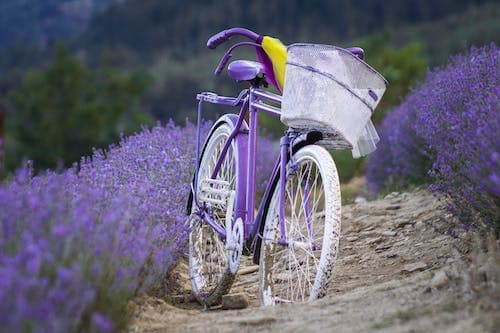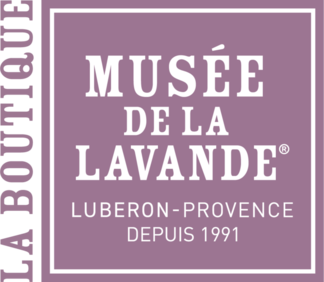MUSEE DE LA LAVANDE LUBERON- 276 Route de Gordes -CS50016- 84220 COUSTELLET
04 90 76 91 23 |

Each day, we share with you our passion for this delicate bleue flower.
Born thousands years ago in the heart of Haute-Provence, it offers us its benefits and all of its charm with its delicious perfume representing south of France.
Contact us for any request or questions, or let yourself be seduced by the organic cosmetics range and niche perfumes we elaborate while having the greatest respect of nature.
Shop le Château du Bois at the Luberon Lavender Museum

Where to find lavender fields in France ?
Where to Find Lavender Fields in France?
In France, lavender fields attract numerous tourists, visitors, and photographers from all around the world every year. Whether for a weekend getaway or a holiday escape to Provence, visiting lavender fields is an absolute must. This beautiful aromatic plant has been harvested in the wild since ancient times. It's the unparalleled fragrance that has led to the rapid growth of lavender's popularity. From the Luberon to the Valensole plateau, from the Provençal Drôme to the Vaucluse mountains, there are many stunning places to explore and fascinating details to learn about botany, lavender's history, and its cultivation.
Why is there such an attraction to lavender fields?
Similar to the tulip fields in the Netherlands, lavender fields in France have captured the hearts of nature and photography enthusiasts. Walking through the fields of "blue gold" offers an unforgettable day in an enchanting setting steeped in history.

Some dedicated lavender growers resist the industrialization of lavender essential oil production, especially in the world of true lavender compared to lavandin. Often, they open their doors to visitors, sharing their expertise and fascinating anecdotes.
If you spend time in the South during summer, you can gather beautiful memories and artisanal lavender-based products. It's a unique opportunity to make new connections and find original gifts for yourself and your loved ones!
Where to Go to Admire Lavender Fields?
To wander through lavender fields in France, the two most renowned regions are Vaucluse and Alpes-de-Haute-Provence. When the cicadas sing and the bougainvillea blooms, it's time to discover or rediscover the lavender fields.
Follow the lavender route that traverses north to south through the two most beautiful regions where true lavender and lavandin fields are cultivated.
You'll have about 1200 km of road to explore the mountains, the sun, a unique terroir, and an exciting history, constituting a precious heritage.
You can start from the north, south, east, or west – the key is to remember your camera and join one of the lavender routes closest to your arrival point in Provence!
All the condensed and beautifully presented information can be found on the Lavender Routes website, and don't forget to grab the paper brochure at the Lavender Museum in Luberon!
Among them, the Valensole plateau in Alpes de Haute-Provence, between Manosque and Sisteron, offers a perfect view of the vast fields of lavandin as far as the eye can see.

In Vaucluse, the plateaus of Sault and Albion offer a different visual experience with smaller, almost private plots nestled in the mountains surrounded by beech, oak, and fir forests. Sometimes, you can even catch a glimpse of the Alpes de Haute-Provence or Mont Ventoux.
Admiring a lavender field in Provence is a distinct and memorable experience.
However, it's crucial to keep in mind that these beautiful purple lands still belong to farmers for whom their lavender is precious. So, avoid entering the fields, respect the place by not leaving any litter behind, and refrain from touching the plants. During the flowering season, the flowers are delicate and laden with essential oil, so just use your eyes to enjoy!
When to Admire Lavender Fields in France?
Before embarking on your excursion, note that the best time to admire the "blue gold" fields is during the summer period, specifically between June and August.
While this timeframe is quite broad, several factors come into play for the lavender to reach its flowering stage. Weather conditions vary between regions and altitudes. For instance, the blooming timeline differs between the plains of Luberon and the Sault plateau.
Weather is another factor, as it varies from year to year, especially with climate change. Additionally, the cultivated lavender variety also influences the plant's blooming period.

In any case, note that true lavender, when traditionally and naturally propagated (through seeds and without cuttings), is considered a "population" plant. During reproduction, bees pollinate and mix the genes of different individuals, resulting in a genetic blend, which leads to a population of lavenders, each contributing its unique genetic heritage. Just like within a population, they are all different, offering a display of rich variety in terms of size, color, and maturation in blooming.
Lavender Fine Fields
While true lavender or fine lavender grows from an altitude of 800 meters, lavandin is more suited for cultivation in the plains. Lavandin's color is also more uniform compared to fine lavender, which exhibits a myriad of nuances including violet, blue, and gray.
During summer, you can easily distinguish these two lavenders by looking at their stems. Fine lavender has a single floral spike per stem, while lavandin has 3 flowers per stem. Lavandin appears larger and more abundant in flowers.

Indeed, if fine lavender is cultivated and naturally reproduced (through seeds and without cuttings), it becomes a "population" plant. During reproduction, bees pollinate and mix the genes of different individuals, creating a genetic diversity that results in a population of lavenders, each contributing its unique genetic heritage. Just like in a population, they are all different, offering a spectacle of great richness with beautiful nuances in size, color, and flowering maturity.
Cultivation of Lavandin
Since the 1950s, the cultivation of lavandin has become more popular due to its higher essential oil yield compared to fine lavender. As a result, lavandin essential oil is more accessible and less rare. However, don't be mistaken – these are two very different oils. Lavandin essential oil, which has a stronger and camphoraceous scent, is used in laundry powders and industrial products. It should not be applied directly to the skin, unlike fine lavender.
In fact, all you need to do is smell true lavender and lavandin side by side to immediately notice the difference. Lavandin has a much less subtle and more camphoraceous aroma. While it's useful for household and home products, it doesn't find its way into perfumes or body care products. Only the scent of true lavender possesses the sought-after olfactory virtuosity by master perfumers.

Furthermore, just smelling true lavender and lavandin flowers one after the other is enough to detect the difference immediately. Lavandin has a much less subtle and more camphoraceous aroma. While it's useful for household and home products, it doesn't find its way into perfumes or body care products. Only the scent of true lavender possesses the sought-after olfactory virtuosity by master perfumers.
Good Practices to Adopt During a Lavender Field Visit
While lavender fields evoke genuine enthusiasm both nationally and internationally, they are also somewhat victims of their success. Indeed, the influx of tourists mixed with general excitement sometimes affects the crops. It's common for some people to forget to be mindful of not trampling or picking the lavender.
You might notice that some fields are now fenced to protect the crops. These fields remain private properties, and being able to visit them is a privilege. Visits provide an opportunity to appreciate lavender while respecting the plantations, enjoying its fragrance, and immersing in the relaxing atmosphere.
Lavender-related visits are centered around discovery, contemplation, and encounters with passionate lavender growers. Our museum is designed to offer you an extraordinary sensory journey. By visiting us, you'll discover the history of lavender from the 16th century to today, as well as a charming boutique where high-quality artisanal products await.
